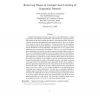Free Online Productivity Tools
i2Speak
i2Symbol
i2OCR
iTex2Img
iWeb2Print
iWeb2Shot
i2Type
iPdf2Split
iPdf2Merge
i2Bopomofo
i2Arabic
i2Style
i2Image
i2PDF
iLatex2Rtf
Sci2ools
IDA
2007
Springer
2007
Springer
Removing biases in unsupervised learning of sequential patterns
Unsupervised sequence learning is important to many applications. A learner is presented with unlabeled sequential data, and must discover sequential patterns that characterize the data. Popular approaches to such learning include (and often combine) frequency-based approaches and statistical analysis. However, the quality of results is often far from satisfactory. Though most previous investigations seek to address method-specific limitations, we instead focus on general (methodneutral) limitations in current approaches. This paper takes two key steps towards addressing such general quality-reducing flaws. First, we carry out an in-depth empirical comparison and analysis of popular sequence learning methods in terms of the quality of information produced, for several synthetic and real-world datasets, under controlled settings of noise. We find that both frequency-based and statisticsbased approaches (i) suffer from common statistical biases based on the length of the sequences co...
Frequency-based Approaches | IDA 2007 | In-depth Empirical Comparison | Information Technology | Unlabeled Sequential Data |
Related Content
| Added | 14 Dec 2010 |
| Updated | 14 Dec 2010 |
| Type | Journal |
| Year | 2007 |
| Where | IDA |
| Authors | Yoav Horman, Gal A. Kaminka |
Comments (0)

